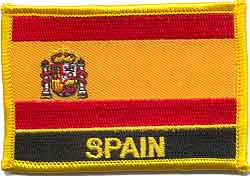|
Spain - January - February 1949
Vicky Blitz
[Previous: Click on Countries - Portugal]
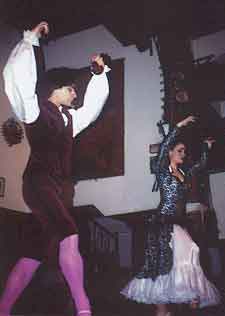 We arrived by bus in Seville about 5:00 p.m. and checked into the the Colon Hotel. I had a delicious salmon dinner with fellow travelers in the hotel, after which we attended a wonderful
flamenco show. As I got a seat on the front row, I used up a whole roll of film on the dancers and it was worth it. It is not often one is lucky enough to be in a tour group and be seated on the front row. We arrived by bus in Seville about 5:00 p.m. and checked into the the Colon Hotel. I had a delicious salmon dinner with fellow travelers in the hotel, after which we attended a wonderful
flamenco show. As I got a seat on the front row, I used up a whole roll of film on the dancers and it was worth it. It is not often one is lucky enough to be in a tour group and be seated on the front row.
Expo '93 had been held in Seville a year earlier and had resulted in the city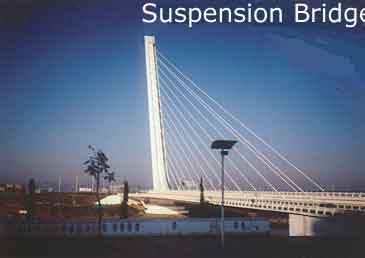 building seven new bridges, a couple of new and radical design, one of which
(a suspension bridge) I include here. They were awesome as I had never seen anything like it, not even in pictures. In fact, all of us were
duly impressed and said so. building seven new bridges, a couple of new and radical design, one of which
(a suspension bridge) I include here. They were awesome as I had never seen anything like it, not even in pictures. In fact, all of us were
duly impressed and said so.
The last Expo to be held in Seville before 1993 was in 1927 and Alphonso XIII had built the most awesome and marvelous square, with fifty panels, each representing one of the provinces
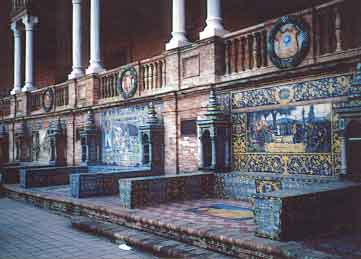 of Spain. Each picture panel [see
pictures] was done in tiny blue ceramic tiles, inset in a retaining wall, beyond which was an
esplanade and rooms which have now been turned into city and military offices. On the lower level, parallel to the retaining wall is a walkway and canal, over which is an
exquisite arched bridge also done in little blue ceramic tiles. The over-all impression is
palatial. of Spain. Each picture panel [see
pictures] was done in tiny blue ceramic tiles, inset in a retaining wall, beyond which was an
esplanade and rooms which have now been turned into city and military offices. On the lower level, parallel to the retaining wall is a walkway and canal, over which is an
exquisite arched bridge also done in little blue ceramic tiles. The over-all impression is
palatial.
Also on our morning tour was Maria Luisa Park with its pools and fountains, the Gold
Tower on the Guadalquivir River, and the fine Baroque building which is now the university but used to be the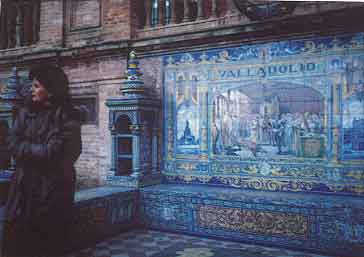 tobacco factory of Carmen fame. We also visited the
Cathedral with the tomb of Columbus, and took a walking tour through the charming
Santa Cruz quarter. tobacco factory of Carmen fame. We also visited the
Cathedral with the tomb of Columbus, and took a walking tour through the charming
Santa Cruz quarter.
The afternoon was free and our hotel was within walking distance of our hotel, so I set out on my usual quest for a gold bangle to commemorate my trip to Spain. After wandering through the shopping district for a couple hours and finding that bangle, I started back to the hotel, but I only knew the general direction and I realized I would need a little assistance. My mind turned back to my college days when I
barely squeaked by two years of Spanish.
My memory did not fail me and I remembered one essential word, "donde", which means "where". So all the way back to the hotel, I would go a block, stop someone and ask "Perdone me. Habla usted el
Ingles?" (Excuse me, do you speak English?) They would say "no" and then I would say "Donde es Hotel Colon?" (Where is the Colon Hotel?) Now, I had absolutely NO idea what a single person replied, but along with their directions they would always point
in the direction, I would say "Gracias" and go up to the next block and ask again. I
have never been more pleased with myself, even through I was only faking it. And, by the way, I DID get back to my hotel.
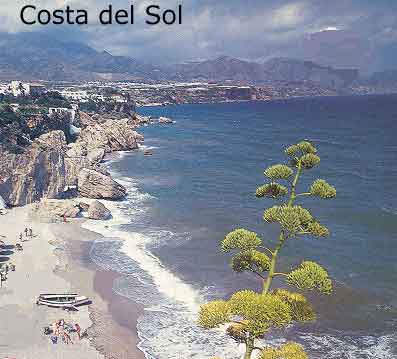
The following day we left Spain for about a week to tour Morocco and
Gibraltar. [Click on: Countries - Morocco]. We spent the first night back
on Spanish soil in a lovely, modern hotel in Costa del Sol. Being the off
season, we were among the few people there and were able to stroll the
beach without the crowds that are there in the summer. With all the
high-rise hotels and apartments I'm sure the crowds during the summer
would be uncomfortable for me, as I prefer my solitude.
On to Granada and another five star hotel where we checked in about
1:30 p.m. and then went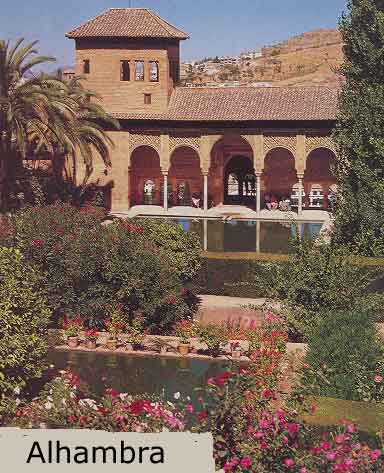 out to tour the Alhambra before dinner. Let me quote from the Globus tour
brochure:
out to tour the Alhambra before dinner. Let me quote from the Globus tour
brochure:
"ALHAMBRA. The mighty yet graceful citadel was planned by the 13th
century Moorish ruler Al Ahamar. A fantasy of 'lace in stone', surrounded
by arabesque gardens and fountains, it affords superb views of the Old Quarter
and Sacromonte, a mountain occupied by gipsy cave-dwellers. Also amble
through the exotic WATER GARDENS OF THE GENERALIFE, the royal summer
residence."
I just couldn't say it better myself, and yet there are no words to
convey the beauty, the serenity, the ambiance. I could not help but wonder
how it was when it was occupied. Was it as 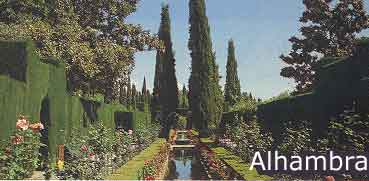 peaceful?
Were the residents happy? Did they appreciate their home? Did they have
large families, many guests, many servants? Was it lonely? peaceful?
Were the residents happy? Did they appreciate their home? Did they have
large families, many guests, many servants? Was it lonely?
Later that evening we (our tour group) were the only people in our
hotel dining room. Not only was it strange, it was down right spooky.
While we were there I didn't notice any other guests and by the time we
left, I was convinced we were the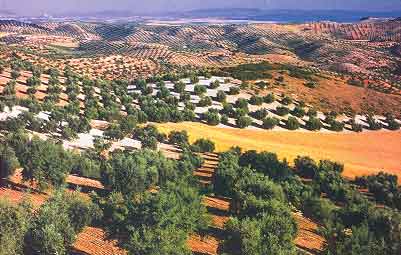 only people in the hotel. Well, that's the off-season, for you.
only people in the hotel. Well, that's the off-season, for you.
Back on the bus the next morning, it was my turn to be in the front
seat and was happy to be there, as we were driving from Granada to Cordoba
and I had my camera ready for pictures of the olive and orange orchards and several
picturesque little towns along the way with their castle or fort on the
top of their local hill.
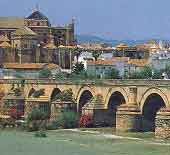 .Once
upon a time the Spanish city of Cordoba was the largest city in the world.
Well, that's what they said. But I know this for sure: Cordoba, and
especially the fabulous Mezquita Catedral de Cordoba (Mosque Cathedral of
Cordoba) is worth it to go out of your way to see it. But, I would advise,
if you can take the time, visit it at your leisure so that you can REALLY
explore all it's nooks and crannies. .Once
upon a time the Spanish city of Cordoba was the largest city in the world.
Well, that's what they said. But I know this for sure: Cordoba, and
especially the fabulous Mezquita Catedral de Cordoba (Mosque Cathedral of
Cordoba) is worth it to go out of your way to see it. But, I would advise,
if you can take the time, visit it at your leisure so that you can REALLY
explore all it's nooks and crannies.
First, however, let me quote directly from the book: "Cordoba lies
in the wide Guadalquivir valley formed between mountains of the Primary
and Tertiary era, or Alpine movement.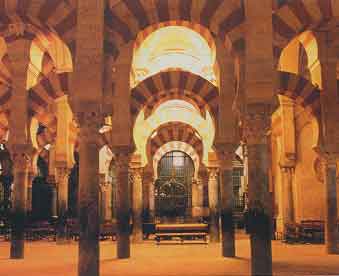
"A settlement in prehistoric times chosen for its privileged
geographical situation, the town was founded by the Roman praetor Marcus,
Claudius Marcelus in 169 BC. as a patrician colony, later to become
capital of the Roman province of Betica.
"Once the Roman unity was broken, Cordoba lived under Visigoth
rule, continuing the decadent Roman system for the three centuries since
it had been so powerfully absorbed.
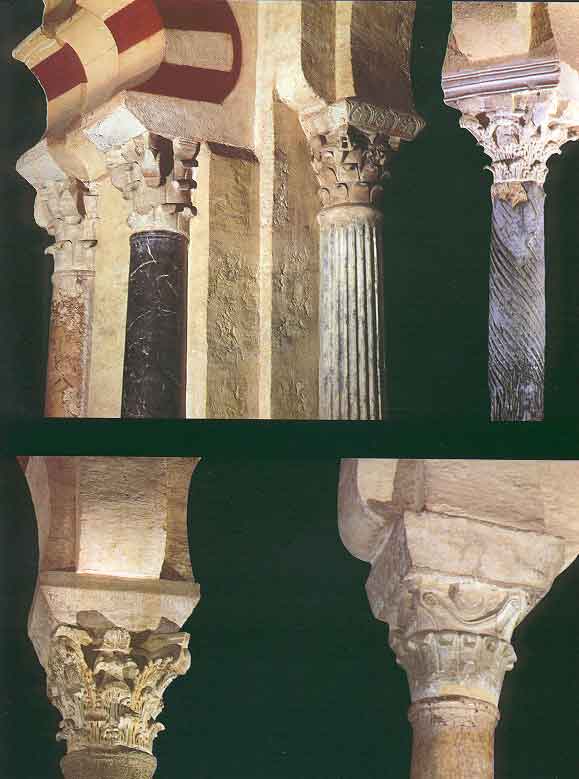 "In
711 the Hispanic world changed. Visigoth disruption justified the Muslim
invasion from North Africa, integrating the Iberian Peninsular in the
Islamic world as Al Andalus, an emirate, subject to Damascus, with Cordaba
as capital from 716. "In
711 the Hispanic world changed. Visigoth disruption justified the Muslim
invasion from North Africa, integrating the Iberian Peninsular in the
Islamic world as Al Andalus, an emirate, subject to Damascus, with Cordaba
as capital from 716.
"Abd ar Rahman, "the emigrant", a prince from the fallen Omeyad
dynasty, supplanted by the Abbasies, proclaimed in 756 the independence of
Western Islam, reigning as Abd ar Rahman I. Of intelligent and energetic
character he made Muslim Spain a strong and organized state.
"A royal court or "jassa", began to develop in the
appointed capital, Cordoba. As it grew it became necessary to build an
"Aljama" (main) Mosque.
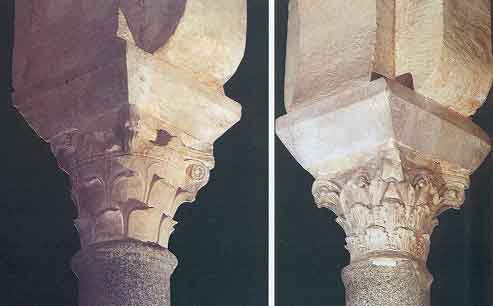 "Construction
started in 785 on a small promontory over the Guadalquivir, on a site
already sacred in other religions. Occupied by a Visigoth hermitage to St.
Vincent, used by Muslims as a Mosque, and according to local scholars, a
Roman temple, where since the 2nd. year BC. the Gods were invoked for
victory. This theory is based on the discovery of two columns with an
inscription of Janus Agustus; now exposed in the "Patio de los
Naranjos", (Orange Tree Court). "Construction
started in 785 on a small promontory over the Guadalquivir, on a site
already sacred in other religions. Occupied by a Visigoth hermitage to St.
Vincent, used by Muslims as a Mosque, and according to local scholars, a
Roman temple, where since the 2nd. year BC. the Gods were invoked for
victory. This theory is based on the discovery of two columns with an
inscription of Janus Agustus; now exposed in the "Patio de los
Naranjos", (Orange Tree Court).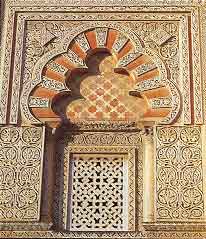
"The building of all mosques begins with the "Kibla"
wall facing Mecca, Mohommed's birthplace in 569, pilgrim center on the
Red Sea.
"Mosque and Aljama are words of Arabic origin ; the first
indicating a place of worship, the second, meeting or assembly."
The rain that followed us that morning did not diminish the splendor of
the mosque nor our appreciation of what the architects had accomplished in
this endeavor. The pride of the local tour guide was certainly well
founded.
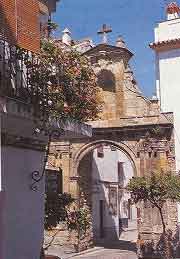 During
the walking tour of the old quarter the rain eased up and we only had to
contend with wet and slippery streets. At one point our guide proudly
reported that we were in the Old Jewish Quarter. Someone asked if there
were any Jews living there now and he replied ":no" ...of
course, not since the inquisition when the Jews in Spain were given three
options: convert to Christianity, leave the country or die. But we were
too polite to mention that little fact. Regardless, I liked this city and
the tour guides were very nice and knew their business. During
the walking tour of the old quarter the rain eased up and we only had to
contend with wet and slippery streets. At one point our guide proudly
reported that we were in the Old Jewish Quarter. Someone asked if there
were any Jews living there now and he replied ":no" ...of
course, not since the inquisition when the Jews in Spain were given three
options: convert to Christianity, leave the country or die. But we were
too polite to mention that little fact. Regardless, I liked this city and
the tour guides were very nice and knew their business.
We left lovely little Cordaba for Toledo and Madrid. There were snow
showers as we passed through the Morano Mountains. We stopped at a
charming little village, Puerto la Pice, for lunch. As the story goes, Don
Quixote was dubbed "knight" here by the inn keeper. The inn
itself and bar were something right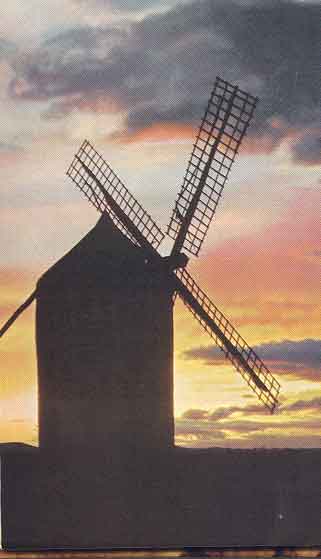 out of a Spanish movie set. The kegs of wine, the old wooden tables and
chairs, the inn keeper himself. Talk about ambiance! They even had a court
yard with a metal statue of Don Quixote.
out of a Spanish movie set. The kegs of wine, the old wooden tables and
chairs, the inn keeper himself. Talk about ambiance! They even had a court
yard with a metal statue of Don Quixote.
Later we passed some windmills and people commented that they must have
been the windmills that the honorable Don had battled so long ago.
We stopped in Toledo and I got the thrill of a life-time when we
visited a Damascene steel workshop and store.. While all the other women
headed right to the jewelry counters, I made a bee-line for the swords.
They were beautiful, exquisite and when the sales clerk brought one out
for me to handle, although it was heavy, I must say how well balanced it
was. Every molecule in my entire body was excited and thrilled to just
hold the hilt in my hand and maneuver the blade. Very strange.
Undoubtedly, I must have been a swordsman in a previous life.
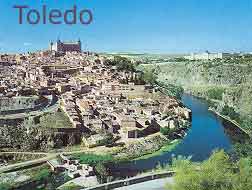 It
is said that this ancient Castilian capital, Toledo, attracts more
sightseers from all over the world than any other Spanish town. Granted it
is situated on a granite hill, surrounded on two sides by the Tagus River.
and makes for a beautiful and unique picture. Our walking tour of the city
included the Moorish bridge, an early synagogue, the 13th-century Gothic
Cathedral and the church of Santo Tome with one of El Greco's famous
paintings. It
is said that this ancient Castilian capital, Toledo, attracts more
sightseers from all over the world than any other Spanish town. Granted it
is situated on a granite hill, surrounded on two sides by the Tagus River.
and makes for a beautiful and unique picture. Our walking tour of the city
included the Moorish bridge, an early synagogue, the 13th-century Gothic
Cathedral and the church of Santo Tome with one of El Greco's famous
paintings.
And, finally, our last stop was Madrid, the capital of Spain since
1561. It is a modern city, as one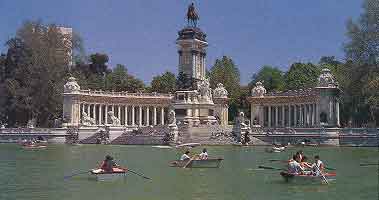 might expect. We did a morning tour, both by bus and some walking. We saw
the Puerta del Sol, Plaza Espana with its monument to Cervantes, the
Parliament, Cibeles Fountain, Calle Alcala and Paseo de Castellana. The
highlight was a visit to the palatial Prado Museum with its priceless art
treasures. The picture accompanying this paragraph is El Retiro Park,
originally the grounds of a royal retreat.
might expect. We did a morning tour, both by bus and some walking. We saw
the Puerta del Sol, Plaza Espana with its monument to Cervantes, the
Parliament, Cibeles Fountain, Calle Alcala and Paseo de Castellana. The
highlight was a visit to the palatial Prado Museum with its priceless art
treasures. The picture accompanying this paragraph is El Retiro Park,
originally the grounds of a royal retreat.
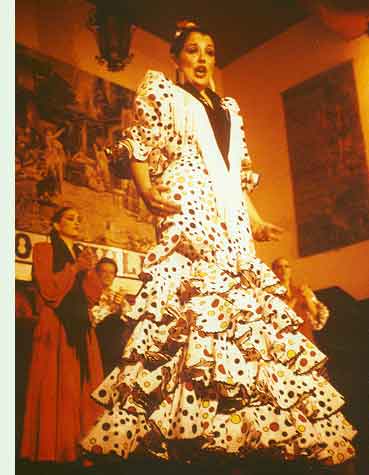 The Spanish lady sang
her song The Spanish lady sang
her song
And threw a rose to me.
I thought she was so beautiful
And charming as can be.
V. Blitz
Seville, Spain
January 1994
THINK
GLOBALLY - ACT LOCALLY - PRAY FOR WORLD PEACE
|
